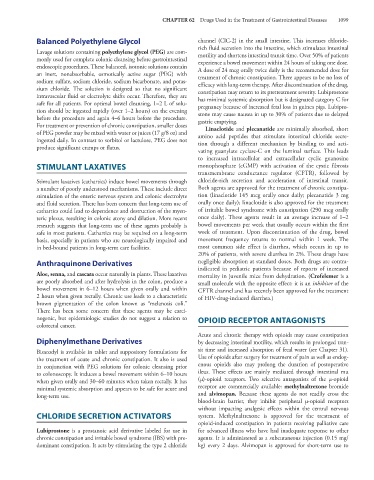Page 1113 - Basic _ Clinical Pharmacology ( PDFDrive )
P. 1113
CHAPTER 62 Drugs Used in the Treatment of Gastrointestinal Diseases 1099
Balanced Polyethylene Glycol channel (ClC-2) in the small intestine. This increases chloride-
rich fluid secretion into the intestine, which stimulates intestinal
Lavage solutions containing polyethylene glycol (PEG) are com- motility and shortens intestinal transit time. Over 50% of patients
monly used for complete colonic cleansing before gastrointestinal experience a bowel movement within 24 hours of taking one dose.
endoscopic procedures. These balanced, isotonic solutions contain A dose of 24 mcg orally twice daily is the recommended dose for
an inert, nonabsorbable, osmotically active sugar (PEG) with treatment of chronic constipation. There appears to be no loss of
sodium sulfate, sodium chloride, sodium bicarbonate, and potas- efficacy with long-term therapy. After discontinuation of the drug,
sium chloride. The solution is designed so that no significant constipation may return to its pretreatment severity. Lubiprostone
intravascular fluid or electrolyte shifts occur. Therefore, they are has minimal systemic absorption but is designated category C for
safe for all patients. For optimal bowel cleansing, 1–2 L of solu- pregnancy because of increased fetal loss in guinea pigs. Lubipro-
tion should be ingested rapidly (over 1–2 hours) on the evening stone may cause nausea in up to 30% of patients due to delayed
before the procedure and again 4–6 hours before the procedure. gastric emptying.
For treatment or prevention of chronic constipation, smaller doses Linaclotide and plecanatide are minimally absorbed, short
of PEG powder may be mixed with water or juices (17 g/8 oz) and amino acid peptides that stimulate intestinal chloride secre-
ingested daily. In contrast to sorbitol or lactulose, PEG does not tion through a different mechanism by binding to and acti-
produce significant cramps or flatus.
vating guanylate cyclase-C on the luminal surface. This leads
to increased intracellular and extracellular cyclic guanosine
STIMULANT LAXATIVES monophosphate (cGMP) with activation of the cystic fibrosis
transmembrane conductance regulator (CFTR), followed by
Stimulant laxatives (cathartics) induce bowel movements through chloride-rich secretion and acceleration of intestinal transit.
a number of poorly understood mechanisms. These include direct Both agents are approved for the treatment of chronic constipa-
stimulation of the enteric nervous system and colonic electrolyte tion (linaclotide 145 mcg orally once daily; plecanatide 3 mg
and fluid secretion. There has been concern that long-term use of orally once daily); linaclotide is also approved for the treatment
cathartics could lead to dependence and destruction of the myen- of irritable bowel syndrome with constipation (290 mcg orally
teric plexus, resulting in colonic atony and dilation. More recent once daily). These agents result in an average increase of 1–2
research suggests that long-term use of these agents probably is bowel movements per week that usually occurs within the first
safe in most patients. Cathartics may be required on a long-term week of treatment. Upon discontinuation of the drug, bowel
basis, especially in patients who are neurologically impaired and movement frequency returns to normal within 1 week. The
in bed-bound patients in long-term care facilities. most common side effect is diarrhea, which occurs in up to
20% of patients, with severe diarrhea in 2%. These drugs have
Anthraquinone Derivatives negligible absorption at standard doses. Both drugs are contra-
indicated in pediatric patients because of reports of increased
Aloe, senna, and cascara occur naturally in plants. These laxatives mortality in juvenile mice from dehydration. (Crofelemer is a
are poorly absorbed and after hydrolysis in the colon, produce a small molecule with the opposite effect: it is an inhibitor of the
bowel movement in 6–12 hours when given orally and within CFTR channel and has recently been approved for the treatment
2 hours when given rectally. Chronic use leads to a characteristic of HIV-drug-induced diarrhea.)
brown pigmentation of the colon known as “melanosis coli.”
There has been some concern that these agents may be carci-
nogenic, but epidemiologic studies do not suggest a relation to OPIOID RECEPTOR ANTAGONISTS
colorectal cancer.
Acute and chronic therapy with opioids may cause constipation
Diphenylmethane Derivatives by decreasing intestinal motility, which results in prolonged tran-
Bisacodyl is available in tablet and suppository formulations for sit time and increased absorption of fecal water (see Chapter 31).
the treatment of acute and chronic constipation. It also is used Use of opioids after surgery for treatment of pain as well as endog-
in conjunction with PEG solutions for colonic cleansing prior enous opioids also may prolong the duration of postoperative
to colonoscopy. It induces a bowel movement within 6–10 hours ileus. These effects are mainly mediated through intestinal mu
when given orally and 30–60 minutes when taken rectally. It has (μ)-opioid receptors. Two selective antagonists of the μ-opioid
minimal systemic absorption and appears to be safe for acute and receptor are commercially available: methylnaltrexone bromide
long-term use. and alvimopan. Because these agents do not readily cross the
blood-brain barrier, they inhibit peripheral μ-opioid receptors
without impacting analgesic effects within the central nervous
CHLORIDE SECRETION ACTIVATORS system. Methylnaltrexone is approved for the treatment of
opioid-induced constipation in patients receiving palliative care
Lubiprostone is a prostanoic acid derivative labeled for use in for advanced illness who have had inadequate response to other
chronic constipation and irritable bowel syndrome (IBS) with pre- agents. It is administered as a subcutaneous injection (0.15 mg/
dominant constipation. It acts by stimulating the type 2 chloride kg) every 2 days. Alvimopan is approved for short-term use to

